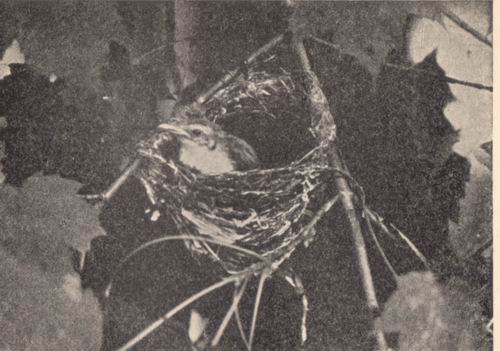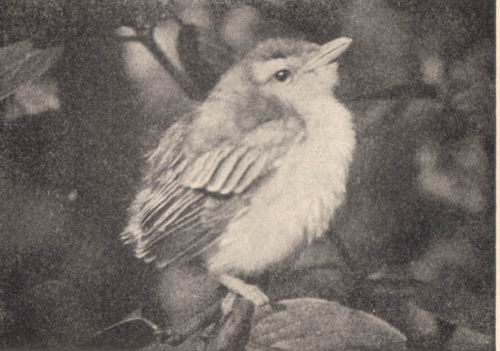|
1999-2004 (Return to Web Text-ures) |
Click Here to return to Birds Every Child Should Know Content Page Click Here to return to last Chapter |
 (HOME) |
|
1999-2004 (Return to Web Text-ures) |
Click Here to return to Birds Every Child Should Know Content Page Click Here to return to last Chapter |
 (HOME) |
|
CHAPTER V
THE VIREOS: ANOTHER STRICTLY AMERICAN FAMILY RED-EYED VIREO WHITE-EYED VIREO YELLOW-THROATED VIREO WARBLING VIREO
THE VIREOS
YOU know that if the birds should suddenly perish, there wouldn't be a leaf, a blade of grass, or any green thing left upon the earth within a few years-it would be uninhabitable. When Dame Nature, the most thorough of housekeepers, gave to the birds the task of restraining insects within bounds so that man and beast could live, she gave the care of foliage to the vireos. It is true that most of the warblers, and a few other birds too, hunt for their food among the leaves, but with nothing like the vireo's painstaking care and thoroughness. The nervous, restless warblers flit from twig to twig without half exploring the foliage; whereas the deliberate, methodical vireos search leisurely above and below it, cocking their little heads so as to look up at the under side of the leaf above them and to peck off the destroyers hidden there-bugs of many kinds and countless little worms, caterpillars, weevils, inchworms, May beetles, and leaf-eating beetles. Singing as they go, no birds more successfully combine work and play. Because they spend their lives among the foliage, the vireos are protectively coloured; with soft grayish or olive green on their backs, wings, and tail, whitish or yellow below. Some people call them greenlets. They are all a little smaller than sparrows. More inconspicuous birds it would be hard to find or more abundant, although so commonly overlooked except by people on the look-out for them. Where the new growth of foliage at the ends of the branches is young and tender, many insects prefer to lay their eggs that their babies may have the most dainty fare as soon as they are hatched. They do not reckon upon the vireos' visits. Toward the end of April or the first of May, these tireless gleaners return to us from Central and South America where they have spent the winter, which of course you know, is no winter on the other side of the equator, but a continuation of summer for them. Competition for food being more fierce in the tropics than it is here, millions of birds besides the warblers and vireos travel from beyond the Isthmus of Panama to the United States and back again every year in order that they may live in perpetual summer with an abundance of food. If any child thinks that birds are mere creatures of pleasure, who sing to pass the time away, he doesn't begin to understand how hard they must work for a living. They cannot limit their labours to an eight-hour day. However, they keep cheerful through at least sixteen busy hours.
THE RED-EYED VIREO
Almost everywhere in the Eastern United States and Canada, the red-eyed vireo is the most common member of his family. The only individual touch to his costume that helps to distinguish him is a gray cap edged with a black line which runs parallel to his conspicuous white eyebrow. He wears a dull olive coat and a white vest. But listen to the Preacher! You have no need to meet him face to face in order to know him: " You see it -- you know it -- do you hear me? -- do you believe it?" he propounds incessantly through the long summer days, even after most other birds are silent. You cannot mistake his voice. With a rising inflection at the end of each short, jerky sentence, he asks a question very distinctly and sweetly, then pauses an instant as if waiting for a reply -- an unusually courteous orator. His monotonous monologue, repeated over and over again, comes to us from the elms and maples in the village street, the orchard and woodland, where he keeps steadily and deliberately at work. Some boys say they can whittle better if they whistle. Vireos seem to hunt more thoroughly if they sing. Like the rest of his kin, the red-eyed vireo is quite -tame. A little girl I know actually stroked the pretty head of a mother bird as she sat brooding in her exquisite nest, and a week later carried one of the young birds all around the garden on a rake handle. Vireos are remarkably fine builders -- among the very best. Although their nests are not so deep as the Baltimore orioles', the shape and weave are similar. The red-eye usually prefers to swing her cradle from a small crotch in an oak or apple tree or sapling, and securely lace it through the rim on to the forked twigs: Nests vary in appearance, but you will notice that these weavers show a preference for dried grass as a foundation into which are wrought bits of bark, lichen, wasps' nest "paper," spider web, plant down, and curly vine tendrils.
THE WHITE-EYED VIREO
It is not often that you can get close enough to any bird to see the white of his eyes, but the brighter olive green of this vivacious little white-eyed vireo's upper parts, his white breast, faintly washed with yellow on the sides, and the two yellowish white bars on his wings help you to recognise him at a distance. Imagine my surprise to meet him in Bermuda, over six hundred miles out at sea from the Carolina coast, where he, too, was taking a winter vacation! In those beautiful islands, where our familiar catbirds and cardinals also abound, the white-eyed vireo is the most common bird to be seen. His sweet, vigorous, irregular interrogation may be heard all day. But there he is known by quite a different name -- "Chick of the Village." It was a pleasant shock to hear, "Now, who are you, eh?" piquantly sung out at me, a stranger in the islands, by this old acquaintance in a hibiscus bush within a few steps of the pier where the steamer landed. In the United States where he nests, his manners are less sociable; in fact they are rather pert, even churlish at times, and never very friendly. Here he loves to hide in such low, briery, bushy tangles as the chat and catbird choose. By no stretch of the imagination would his chic Bermuda name fit him here, for he has little to do with villages and he resents your advances toward more intimate acquaintance with harsh, cackling scoldings, half to himself, half to you, until you, in turn, resent his impertinence and leave him alone -- just what the independent little fellow wanted. He has a strong, decided character, you perceive. His precious nest, so jealously guarded, is a deeper cup than that of his cousin with the red eye, deeper than that of any of the other vireos, and it usually contains three favourite materials in addition to those generally chosen by them: they are bits of wood usually stolen from some woodpecker's hole, shreds of paper, and yards and yards of fine caterpillar silk, by which the nest is hung from its slender fork in the thicket. It also contains, not infrequently, alas! a cowbird's most unwelcome egg.
THE YELLOW-THROATED VIREO
In a family not conspicuous for its fine feathers, this is certainly the beauty. The clear lemon yellow worn at its throat spreads over its vest; its coat is a richer and more yellowish green than the other vireos wear, and its two white wing-bars are as conspicuous as the white-eyed vireo's. Moreover its mellow and rich voice, like a contralto's, is raised to a higher pitch at the end of a sweetly sung triplet. "See me; I'm here; where are you?" the singer inquires over and over again from the trees in the woodland, or perhaps in the village when nesting duties are not engrossing. Don't mistake it for the chat simply because its throat is yellow. As this is the beauty of the family, so is it also the best nest builder.
THE WARBLING VIREO
High up in the top of elms and maples that line village streets where the red-eyed vireo loves to hunt, even among the trees of so busy a thoroughfare as Boston Common, an almost continuous warble in the early summer indicates that some unseen singer is hidden there; but even if you get a glimpse of the warbling vireo you could not tell him from his red-eyed cousin at that height. Modestly dressed, without even a white eye-brow or wing-bars to relieve his plain dusty olive and whitish clothes, he is the least impressive member of his retiring, inconspicuous family. He asks you no questions in jerky, colloquial triplets of song, so you may know by his voice at least that he is not the red-eyed vireo. Some self-conscious birds, like the song sparrow, mount to a conspicuous perch before they begin to sing, as if they had to deliver a distinct number on a programme before a waiting audience. Not so with this industrious little gleaner to whom singing and dining seem to be a part of the stake it for the chat simply because its same performance -- one and inseparable. He sings as he goes, snatching a bit of insect food between warbles. Although towns do not affright him, he really prefers wooded border-land and clearings, especially where birch trees abound, when it is time to rear a family.  A red-eyed vireo baby in his cradle 
Out of it 
Home of the loggerhead shrike, with plenty of convenient hooks for this butcher bird to hang meat on |